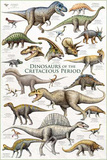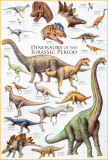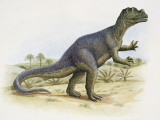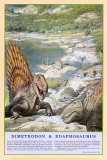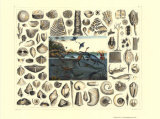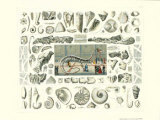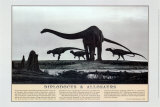|
|
Dinosaurs Educational Posters, Art Prints & Charts, pg 1/2
for the science and social studies classroom, home schoolers, labs, theme decor for office and studio.
|
science > zoology > DINOSAURS 1 | 2 < Pierre Teilhard de Chardin poster
|
|
The word for dinosaur comes from the Greek deinos for monstrous, frightful, terrifying; and sauros for lizard. Dinosaur varieties range from plated and feathered species, the fearsome meat-eaters to mild plant-eaters.
|
|
|
|
|
|
Dinosaur Brachiosaurus
Brachiosaurus was one of the heaviest sauropods of the Late Jurassic, weighing eighty tons and measuring eighty-five feet in length.
Its front limbs were larger than its hind limbs, giving a slope to its body that continued up its long neck. Brachiosaurus could browse on the branches of tall confer trees.
Brachiosaurus were widely distributed, living in North America and Africa.
|
|
|
|
CERATOSAURUS
Late Jurassic. 150 million years ago.
Ceratosaurus was a large theropod dinosaur first discovered in 1884 at the Morrison Formation in Wyoming. Similar to Allosaurus, Certosaurus was bipedal with powerful grasping hands, a short muscular neck and jaws filled with large flesh-tearing teeth. Ceratosaurus had a body ridge over each orbit and a horn on its nose. Individuals were twenty to thirty feet long.
Ceratosaurus were widely distributed, living in North America and Africa.
|
|
|
|
DICRAEOSAURUS
Dicraeosaurus (forked reptile) was discovered in what is now Tanzania in the early 1900's. It differs from other diplodocids (long necked dino's with rod like teeth and divided verebral spines) such as Diplodocus and Apatosaurs (Brontosaurus) in having a relatively short neck, suggesting that it may have browsed on lower-growing vegetation. As usual as Dicraeosaurus's high, deeply forked neck vertebrae were, they were exceeded by those of a bizarre, newly discovered relative, Amargasaurus, from Late Cretaceous Argentina. Now placed in their own subfamily of sauropids or long-necked, big-bodied dinosaurs, both these forms may have had distinctive patterns and colors on their necks to intimidate rivals or to attract mates.
Painting © Mark Hallett, 1990
|
|
|
|
DIMETRODON & EDAPHOSAURUS
Two carnivorous sail-backed Dimetrodons overlook a scattered group of sun-basking Edaphosaurus. The scene is of the Lower Permian of Oklahoma, 280 million years ago. The flora consists of araucaria trees, tree ferns and horsetails. Dimetrodon was a pelycosaur and one of the more advanced reptiles during the Lower Permian. The tall sail may have been used for the regulation of body temperature, gathering warmth from the sun and dissipating excess body heat. This was an advanced form of temperature regulation prior to the development of exothermic metabolism seen today in warm-blooded birds and mammals.
Edaphosaurus was a plant-eating pelycosaur, some ten feet long, which also developed a sail.
Painting © John Sibbick, 1990
|
|
|
|
Dinosaurs- English Edition Poster
|
|
|
Dinosaurs- Art Print
|
|
|
|
|
|
|
|
DIPLODOCUS & ALLOSAURS
On an open expanse of broad flood plain 150 million years ago in Colorado, three Allosaurus stalk a Diplodocus, unable to approach within the sweep of its whip-like tail. Diplodocus was a twelve-ton, ninety-foot-long sauropods that shared the Late Jurassic world. The first fossil remains of Diploducus were excavated in 1878 from the Morrison Formation at Como Bluff in Wyoming during the U.S. expansion into the western interior after the American Civil War.
The Morrison Formation, a unit of rock originating from mud, sand and silt deposited by Late Jurassic rivers, today inderlies a number of western states. The Morrison reveals a rich flora and fauna, including Allosaurus, a carnivorous theropod discovered in 1877. Allosaurus averaged six tons in weight and thirty feet in length, though some individuals were considerably larger. Allosaurus was the largest predator of the Late Jurassic.
Artwork © Doug Henderson 1990
|
|
|
|
Alice B. Woodward, Illustrator
b. 10-3-1862; England
d. 1951
Alice Bolingbroke Woodward, the daughter of a scientist, drew from a young age and by her late teens was skilled enough to illustrate for her father's lectures and for the papers of his colleagues.
Woodward's illustrations for children's books are signed with a butterfly monogram and her scientific work with her signature.
• Peter Pan- Nana Illustration
• women artists posters
|
|
|
previous page | top | dinosaurs, pg 2
|
|
I have searched the web for visual, text, and manipulative curriculum support materials - teaching posters, art prints, maps, charts, calendars, books and educational toys featuring famous people, places and events - to help teachers optimize their valuable time and budget.
Browsing the subject areas at NetPosterWorks.com is a learning experience where educators can plan context rich environments while comparing prices, special discounts, framing options and shipping from educational resources.
Thank you for starting your search for inspirational, motivational, and educational posters and learning materials at NetPosterWorks.com. If you need help please contact us.
|
|
|











